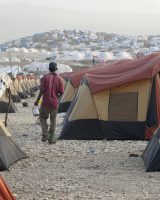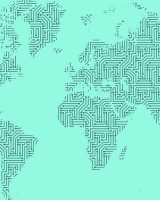IPL is committed to generating high-quality evidence of the benefits possible from using GeoMatch. Our initial research established the connection between geographic placement and economic success using historical data and demonstrated the potential gains from incorporating that information into refugee resettlement programs. Current research builds on this finding, addressing other dimensions of human-centered AI and matching. These include incorporating immigrant preferences, making sure allocations are balanced across locations, and ensuring recommendations don’t benefit some groups at the expense of others. Future research will address challenges of how to use AI-driven tools in the public sector and provide evidence of actual gains in refugee and immigrant integration from using GeoMatch.
Publications

Improving refugee integration through data-driven algorithmic assignment
Kirk Bansak, Jeremy Ferwerda, Jens Hainmueller, Andrea Dillon, Dominik Hangartner, Duncan Lawrence, Jeremy Weinstein
2018
Science
The authors developed an algorithm that incorporates machine learning to place refugees in locations that optimize their employment. Tests using historical data demonstrated the algorithm improved the employment prospects of refugees in the United States by 40% and in Switzerland by 75%.

The authors developed a mechanism that enables the GeoMatch algorithm to incorporate user preferences. The authors demonstrate how the mechanism could assist with two use cases: the assignment of refugee families to host country locations and kindergarteners to schools. This adjustment to the algorithm improves the quality of its recommendations by ensuring they incorporate individual preferences while still improving social welfare.

The authors propose and test two algorithms to match refugees and asylum seekers to locations within a host country. The first seeks to maximize employment levels (or any outcome of interest) for refugees, and the second balances the goal of improving refugee outcomes with the desire for an even allocation across host sites.Test results show very similar employment-maximization for both algorithms, with much better geographic balance for the second, ensuring no single placement site is over- or under- used.

The authors explored different methods for making predictions in situations where the demographic characteristics of refugees and economic characteristics of locations change over time. They considered three methods: the standard approach of using data on past arrivals to predict the (often long-term) policy outcome of interest; an approach that uses newer data on proxy outcomes; and a hybrid approach that leverages both the policy outcome and more recent proxy outcomes. They found that the hybrid approach performed best when tested using data from asylum-seeker placement and early childhood education.
Working Papers

The authors propose a version of the GeoMatch tool that would act as a “decision helper” for economic immigrants coming into Canada. The tool would provide personalized location recommendations that reflect immigrants’ preferences as well as data-driven predictions of the locations where they would be able to maximize their expected earnings. Simulations using data from recent economic immigrants in Canada suggest these recommendations can increase initial earnings and lead to a mild shift away from the most populous landing destinations.

The authors developed a framework for incorporating group fairness into refugee placement so that the gains are more evenly distributed across groups (e.g., refugees with different education levels or countries of origin). Using this framework, the authors test two bid-price algorithms using various definitions of group fairness and real-world data from the U.S. and the Netherlands. These experiments demonstrate the algorithms can improve group fairness with only small decreases in global performance.

Dynamic Matching with Post-Allocation Service and its Application to Refugee Resettlement
Kirk Bansak, Soonbong Lee, Vahideh Manshadi, Rad Niazadeh, Elisabeth Paulson
2024
The authors developed a new learning-based algorithm for dynamic matching that could be used for improving matches between refugees and their locations. The new algorithm eliminates the need for assumptions on the future distribution of refugees that current approaches rely on. When tested on historical data, the new algorithm outperformed existing algorithms used for refugee matching.


